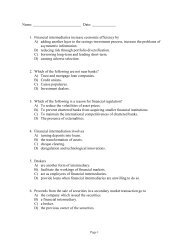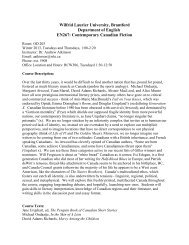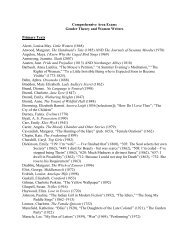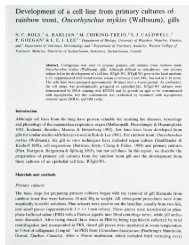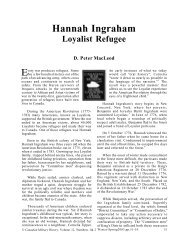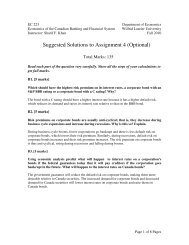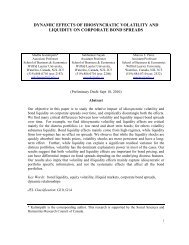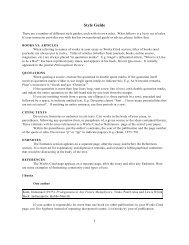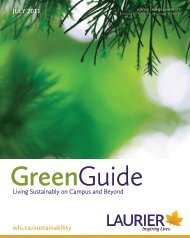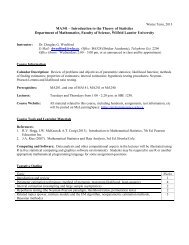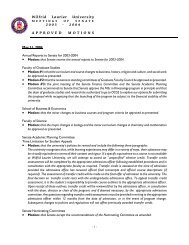Taxonomy of the Polygonum douglasii (Polygonaceae ... - WLU
Taxonomy of the Polygonum douglasii (Polygonaceae ... - WLU
Taxonomy of the Polygonum douglasii (Polygonaceae ... - WLU
Create successful ePaper yourself
Turn your PDF publications into a flip-book with our unique Google optimized e-Paper software.
20 BRITTONIA<br />
[VOL. 57<br />
tween ribs; papillae white, patent or reflexed,<br />
dense, conical-elongate to cylindrical,<br />
100–200 �m. Leaves: basal leaves <strong>of</strong>ten<br />
caducous at flowering, upper leaves<br />
abruptly reduced to scale-like bracts; ocreae<br />
6–12 mm, scaberulous-papillose, free part<br />
lacerate or disintegrating into fibers; blades<br />
linear to narrowly oblong or lanceolate, 15–<br />
70 � 2–8 mm; margins narrowly revolute,<br />
denticulate-papillose; apex acute or mucronate;<br />
papillae on <strong>the</strong> ocreae and leaf margins<br />
are similar to those on <strong>the</strong> stems. Inflorescences<br />
terminal, spike-like, open<br />
thyrses; cymes 2–5-flowered � uniformly<br />
spaced on stems and branches; bracts equaling<br />
or somewhat longer than <strong>the</strong> flowers.<br />
Flowers wide-open or semiopen; pedicels<br />
patent in flower and reflexed in fruit, 0.5–<br />
1 mm; perianth (3.5–)4–5 mm; tube 9–17%<br />
<strong>of</strong> <strong>the</strong> perianth length, perianth lobes petaloid,<br />
cucullate, naviculate only in <strong>the</strong> upper<br />
1/4 part, overlapping, white or pink,<br />
borders white to pink; midveins green, unbranched<br />
or with short lateral branches;<br />
perianth lobe cells elongated, 45–60 � 6–9<br />
�m, with <strong>the</strong> anticlinal walls strongly sinuate;<br />
epicuticular wax pattern <strong>of</strong> type 2,<br />
with a dense intertwined pattern <strong>of</strong> reticulate<br />
rodlets at <strong>the</strong> top <strong>of</strong> cells (Fig. 4F). Stamens<br />
8, an<strong>the</strong>rs pink to purple, 400–500<br />
�m. Pollen <strong>of</strong> type B, 31–33 �m (Fig. 6H).<br />
Achenes elliptic, 3.5–5 mm, enclosed in<br />
perianth at maturity, smooth or tubercled<br />
(Fig. 7E).<br />
Distribution and ecology. Canada<br />
(sou<strong>the</strong>rn British Columbia) and western<br />
United States. It grows in dry plains, meadows<br />
(including serpentine) at elevations <strong>of</strong><br />
500–2000 m.<br />
Phenology. Flowering May–August.<br />
10. <strong>Polygonum</strong> gabrielae Costea & Tardif,<br />
sp. nov. (Fig. 8) TYPE: UNITED<br />
STATES. Oregon. Grant Co.: 7 mi S <strong>of</strong><br />
Mt. Vernon, dry, barren, gravelly, northfacing<br />
serpentine slopes, overlooking<br />
Laycock Creek, T14S, R30E, S26, 1370<br />
m, 29 Jun 1953, Cronquist 7330 (HOLO-<br />
TYPE: NY; ISOTYPES: MICH, MT, OSC,<br />
RSA, UC, WS).<br />
Annuum; caulis glaber, erectus, 3–10 cm<br />
altus; folia oblanceolata vel obovata, 8–20<br />
mm longa; inflorescentia terminalis densissima,<br />
2–5 floribus axillaribus, pedicellis reflexis,<br />
perianthium album, stamina 8;<br />
achaenia 1.8–2 mm longa, elliptica, inclusa<br />
vel paulo exserta. Differt a P. cascadense<br />
bracteis brevioribus paucioribus et pedicellis<br />
reflexis; difert a P. austiniae inflorescentia<br />
densissima, spiciformi, floribus apertis,<br />
perianthio albo, an<strong>the</strong>ris longioribus.<br />
Annual herbs. Stems 3–10 cm long, 4angled,<br />
reddish green erect, zigzagged,<br />
branched below <strong>the</strong> middle, � glabrous.<br />
Leaves: basal leaves persistent at flowering,<br />
upper leaves gradually transformed into a<br />
few bracts; ocreae 2–5 mm, funnelform,<br />
glabrous, free part hyaline � lacerate;<br />
blades oblanceolate, spathulate or obovate,<br />
8–20 � 3–4.5 mm, margins plane or very<br />
narrowly revolute, smooth, apex acute to<br />
mucronate. Inflorescences terminal, spiciform,<br />
dense; cymes 2–5-flowered aggregated<br />
and overlapping at stem and branch apices;<br />
bracts scarce, shorter or equaling <strong>the</strong><br />
flowers <strong>the</strong>y subtend. Flowers wide-open<br />
(Fig. 3D); pedicels 0.5–2 mm, patent at<br />
flowering and reflexed in fruit; perianth<br />
2.2–2.6 mm, tube 8–15% <strong>of</strong> <strong>the</strong> perianth<br />
length; perianth lobes petaloid, cucullate,<br />
naviculate, parallel (Fig. 3E), pure white,<br />
with green unbranched mid-veins (which<br />
may be brownish on dried material); perianth<br />
lobe cells are elongated, 55–65 � 8–<br />
12 �m, with <strong>the</strong> anticlinal walls strongly<br />
sinuate; epicuticular wax pattern <strong>of</strong> type 2,<br />
with a dense pattern <strong>of</strong> intertwined rodlets<br />
interrupted by small unsculputured spaces<br />
at <strong>the</strong> top <strong>of</strong> cells (Fig. 5D). Stamens 8,<br />
an<strong>the</strong>rs purple, 325–380 �m. Pollen <strong>of</strong> type<br />
B, 27.4–30.1 �m (Fig. 6G). Achenes elliptic,<br />
1.8–2 mm, enclosed or slightly exserted<br />
from <strong>the</strong> perianth at maturity, smooth (Fig.<br />
7I).<br />
Hickman (in herb.) identified collections<br />
<strong>of</strong> P. gabrielae as ‘‘P. cascadense with<br />
characteristics <strong>of</strong> P. <strong>douglasii</strong>.’’ Although<br />
distinct, P. gabrielae shares some features<br />
with P. austiniae and P. cascadense; however,<br />
it differs by a dense terminal inflorescence<br />
with overlapping cymes, wide-open<br />
flowers with white perianth lobes, an<strong>the</strong>rs<br />
over 300 �m long, and pollen <strong>of</strong> type B. In<br />
contrast, P. austiniae has an open, elongated<br />
inflorescence with widely spaced cymes,



